
Have you ever been out and about and come across a dog breed that makes you say, “Wow! What kind of breed is that?”. If you haven’t, there is a good chance that running across the phantom bernedoodle will cause that reaction.
You are about to take a journey of discovery into the specific world of the Bernedoodle Phantom. So whether you’re looking to purchase a new fur baby or maybe you just want to know more about these brilliant, social butterflies, you’ve come to the right place.
Other articles you would like: How To Train A Bernedoodle? and What Is A Bernedoodle’s Lifespan?
Table of Contents
Bernedoodles
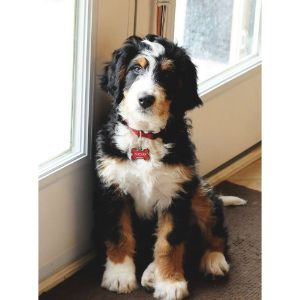
Before we dive into the specific facts about the phantom bernedoodle, let’s give some context about the Bernedoodle breed in general.
These wavey-haired wonder babies are a relatively new designer breed. They originated in 2003 from a combination of a Bernese Mountain dog and a Poodle.
As demand for larger hypoallergenic breeds rose, so did the popularity of Bernedoodles. These beautiful socialites can come in various sizes and require lots of mental and physical exercise to keep them happy.
In addition, because of their poodle heritage, they have acquired a low shedding coat. This trait requires frequent maintenance to prevent painful mats from forming.
This breed can be quite expensive. Due to the high demand, the price tends to be higher than most mixed breeds. If you’re looking for a toy variant, you may spend between $2,500 and $5,000.
Traits
- Height – 15-29 inches
- Weight – 50-90 lbs
- Lifespan – 12 years
- Temperament – Intelligent, Social, Friendly
Phantom Bernedoodle
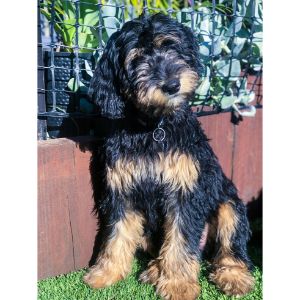
So now that you have a better understanding of the breed, let’s jump into Phantom Bernedoodles specifically.
When referring to a full-grown Phantom Bernedoodle, it is referencing a particular color pattern of Bernedoodles. Phantoms are typically all black coats with tan accents, although the Poodle heritage can add light colors to the design.
Are you intrigued yet? Excellent! Let’s move into some interesting facts about our new friends.
10 Facts About Phantom Bernedoodles

Having an understanding of the Bernedoodle and what is considered a Phantom clarified, we can start learning about specific nuances about Phantoms.
1. Phantoms Come in Different Types
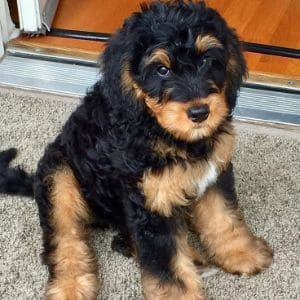
A Phantom Bernedoodle, as stated above, is a Bernedoodle with a solid colored coat with the second color around the nose, chest, and legs.
But because of its heritage, it can be tricky to predict which color combination breeders will get, resulting in several variations. These variations can be:
- Standard Phantom Bernedoodle – This is the most common and widely recognized version. Typically an all-black coat with tan accents around the nose, chest, and legs, standard phantoms can also come in cream and silver or black and cream.
- Tricolor Phantoms – These are the hardest to reproduce and match the all-black coat with tan around the nose and legs of the standard variants. The difference is that the tri-colored variant has a patch on its chest.
- Sable Phantom – This variant has a very striking appearance. They have a solid-colored coat but have black tips to the hair. Unlike other phantoms, they are only available in multiple-generation Doodles.
- Merle Phantom – These variants are exquisitely beautiful creatures, and it’s hard not to stare at them. They will have merle markings and a white nose, chest, and legs.
- Chocolate Phantom – This variant has a rich dark brown body and tan markings. The beautiful color patterns make this variant easy on the eyes.
2. Phantoms Require More Care
When caring for your fur baby, size and color won’t make a difference. However, this breed has high intelligence and is in the working dog category, meaning you will need to train and exercise your pet to keep him happy.
The good news is that this breed loves to please its owners, resulting in a quick training process if done right.
Bernedoodles will have wavy or curly hair that is generally hypoallergenic and has minimal shedding. Unfortunately, minimal shedding means grooming is a must. You will need to spend time brushing and detangling its coat every day to prevent matting.
Grooming is an excellent opportunity to bond with your pet. The time spent may feel like work, but if you look at the process as a chance to grow the bond with your companion, you won’t see it as a chore.
3. Phantoms Aren’t Without Health Conditions
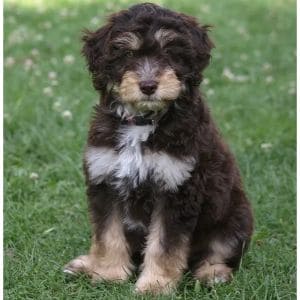
When talking about mixed breeds, we often think of them as healthier than purebreds. While this can be the case, it doesn’t mean they are free of health concerns.
For example, adult Phantom Bernedoodles may be healthier than their parent Poodle or Bernese Mountain, but they will still have conditions to monitor. Some health conditions to be on the lookout for:
- Cancer
- Hip and elbow dysplasia
- Eye disease
- Skin issues
Spending time researching breeders and doing your due diligence will assist in preventing these possible health conditions.
Quality breeders will invest in health testing to ensure they aren’t breeding problems into the next generation of Phantom Bernedoodle puppies. A healthy puppy is also part of what you pay for when you go to a breeder.
4. Phantoms are Good for Families
When you mix the intelligence of a Poodle with the calm and loyal qualities of a Bernese Mountain dog, you can see why a Bernedoodle makes a great family companion.
Phantom variations share all the qualities that make this breed lovable. Some inherited traits to watch out for include stubbornness, a wariness of strangers, and high energy.
With training and socialization, you can counter stubborn and wary traits. High energy isn’t necessarily a bad trait, but managing the energy with appropriate walk times of an hour to an hour and a half will curb some of this.
By teaching the children of the house how to play appropriately with Cpt. Fuzzybottoms, you can prevent any high-energy nipping in certain circumstances.
5. Bernedoodle Phantoms Need Less Exercise than Other Doodle Crossbreeds
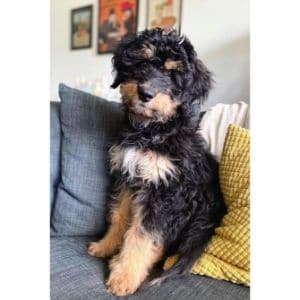
Yes, Phantoms are a working breed and require adequate mental and physical stimulation.
However, compared to a Labradoodle or a Goldendoodle, the Phantoms and the rest of the Bernedoodle variants need only about an hour and a half of moderate exercise to maintain a healthy, happy pup.
It is important to note that the different sizes of Bernedoodle will require more or less physical activity. In addition, the smaller toy and mini breeds will need a little more to counter their energy levels.
6. Phantoms Hate Being Left Alone
Phantoms have prominent personalities and are goofy, affectionate, and intelligent. If you spend time at an office or intend on being away from your Bernedoodle, you may want to reconsider getting a Phantom.
Compatibility is a significant factor in finding the right breed for your circumstances. For example, because Phantoms hate being left alone for an extended period, they can develop behavioral problems like destructive tendencies and anxiousness.
7. Phantoms Can Live to be 18 Years old
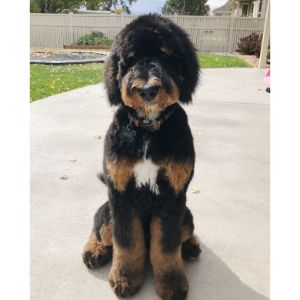
Because the Phantom is a mixed breed, they tend to be healthier than their pure-bred parents. They can contract health conditions, but it isn’t unheard of for this breed to live as long as 18. A significant factor in this is size.
When it comes to dogs in general, their life span and their size are directly connected. Most breeds follow the standard that the larger the dog, the shorter the lifespan. These facts bring us now to our next topic.
8. Phantoms come in Three Sizes
Just like many other breeds, the Bernedoodle Phantoms can vary in size. The toy variant can measure as little as 12 inches and 10 lbs.
In contrast, the standard variant can be as large as 29 inches and 90 lbs, with the Phantom Mini Bernedoodle variant landing somewhere in the middle.
Choosing the right size will mean considering energy requirements, living space, and even grooming needs—the smaller the dog, the less surface that needs brushing.
9. Not a Recognized Breed
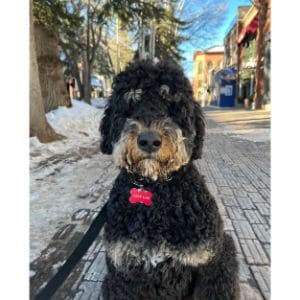
Most kennel clubs won’t recognize any breeds considered designer or mixed-breed.
So when considering how difficult it can be to get the specific Bernedoodle patterns, along with this breed considered designer, we can see why the AKC, UKC, and CKC haven’t recognized them.
10. Can be Expensive
Bernedoodles, in general, can be expensive due to the high demand. Phantoms, in particular, can be challenging to obtain and can be as expensive as $3000.
If time or money is a factor, you may consider getting a pattern that isn’t as pricey or in high demand. A solid color puppy would still love you with the Bernedoodle passion, and you might be able to get him cheaper and quicker.
Conclusion For “Facts About the Phantom Bernedoodle”
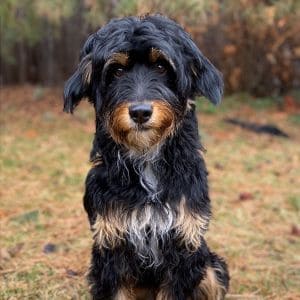
Whether you’re rescuing an adult Bernedoodle or purchasing your first Phantom puppy, there isn’t much difference other than color.
They inherit a great disposition and sweet personality, regardless of color. This breed can be expensive, but it is adaptable and willing to please.
Having a high intelligence and energy, you may think that apartment living may not be appropriate for this breed, but if they are exercised regularly and walked daily, this breed will be right at home no matter where you live.
You will also like:
For more information about the Phantom Bernedoodle Breed, check out the video below:




